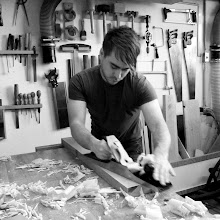
This week I cut a set of mortise and tenon joints for the base of a display case. I decided that I would try out the new mortising chisels I got last month and some sweet new sawing skills that I have been working on. After carefully cutting and fitting the parts, I started thinking about how all of the time and effort put into these joints would be hidden from view the moment that I placed glue into the joint and clamped up all of the parts. I also considered about the myriad other ways in which this joint could be constructed(i.e. dowels, dominos, screws, biscuits, etc.) or handful of less manual techniques that could be employed to the form the parts (i.e. mortising machine, a router jig, table saw, drill press and on and on and on…)
The question is why bother this sort of thing by hand?
Here are some of my thoughts:
1. Enjoyment
I am not a production shop. I make one-offs and low volume small batches of things. I enjoy my time in the shop and my time is made more enjoyable having intimate contact with the material (dirty minds). Trust me I am not a purist of any kind, the moment I need to make 100 of something you bet I’ll be going the machine route. However, whenever possible I always prefer the most direct approach to craft. A direct approach being the path that minimizes the barriers between you, your tools and your material. I would argue that there are very few activities more direct then bashing in mortises with a sharp pigsticker, or sawing down a knife line with a backsaw. Fun fun stuff!
2. Speed kills
Most times there is an inverse relationship between speed and control. Often tools and techniques that are “fast” lead to mistakes happening more quickly. I can’t tell you the number of times I have blown past a mark or cut something on wrong side of a mark and simply had to toss the pieces I was working on. Working by hand is slower, which means that either mistakes happen much slower or can be adjusted for in between saw strokes or plane shavings. As in most cases, I didn’t really have time to botch these legs and start again so I took the slow and steady approach. Also, going back to no.1- while not as efficient, or fast, handwork is deeply satisfying and why would you want to rush through that.
3. It’s not what you can make…
…it’s what you can fix. I would love to tell you that every joint comes off perfect square and clean off the saw cut, but I would also like to tell you that unicorn poo is actually strawberry ice cream with sprinkles (the latter is actually up for debate). Even cutting tenons with a stacked dado set on a table saw, the joints can be rough and need clean up to fit properly and have good gluing surface. If you learn how to cut a joint by hand the tricks you learn to clean and fit a joint will be in valuable no matter what the process you use. You’ll also be amazed at how you can make a strong square joint out of (very) less than square parts.
4. Versatility
Having the tools and skills to do something by hand gives versatility and flexibility in the way that you work and the things you are able to design and implement. One of the problems with specialized equipment is being stuck with the functional parameters of this machinery, or the perception of you capabilities. You see this all the time with people who watch woodworking on tv and think you need to have a specific machine or specialized jig for every woodworking task. The bottom line is the that basic the hand-working tool kit is relatively small and when you pair it with modest collection of modern machines, your capabilities(skills) are greatly expanded.
Anyway, back to the joints:
I feel like good joinery is like keeping a secret well. If you do a poor job, it will be plain to see or it won’t take long for the cat to be out of the bag. But if you do a good job you wont hear anything at all and no one will be the wiser. In fact the joint might not every really get notice because the viewer/user will be too preoccupied with the piece simply working as it should. Ninja.
So how did I do? Well, the glue is in, the clamps are off, every thing has been cleaned/finished, and the piece is sitting in a gallery right now. The joints are quietly keeping the details of their constitution a secret. If I did my job correctly, my joints their secret will be safe for a long long time.

Also, if the dings, dents, plane tracks weren’t enough, I very consciously left my crimson makers mark on the inner surfaces of the of the table aprons.


1 comment:
The free robux generator is a very amazing tool for the free robux generation for the free roblox game.
Post a Comment